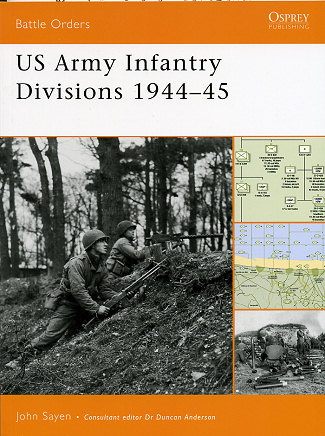 Number 24 in Osprey's 'Battle Orders' series is this one on US Army
Infantry Divisions 1944-45.
Number 24 in Osprey's 'Battle Orders' series is this one on US Army
Infantry Divisions 1944-45. |
Title: |
US Army Divisions 1944-45 |
|
Author: |
John Sayen |
|
Publisher/Distributor |
Osprey Publishing |
|
Price |
$23.95 MSRP |
|
Reviewer: |
|
| Notes: | 96
pages, 7¼ x 9¼ inches,
softcover ISBN:978-1-84603-119-9 |
 Number 24 in Osprey's 'Battle Orders' series is this one on US Army
Infantry Divisions 1944-45.
Number 24 in Osprey's 'Battle Orders' series is this one on US Army
Infantry Divisions 1944-45.
Those not intimately involved with the organization of military units probably does not think of a great many things that are needed to keep these units smoothly operating. When I was in the Navy, it took me a considerable amount of time to get used to how things were done, why they were done in that manner and why there were only so many people to do certain jobs. Often times, much of what our unit required was not done 'in house' but needed the assistance of specialists from a higher echelon in our chain of command. Understanding the juxtaposition of these various units in regards to one's own needs went a long way in being able to use the system to its best benefit (and also in helping to circumvent it when the needs arose!).
During the early 1940s, Lt Gen. Leslie McNair was tasked to take a good look at how the US Infantry did its work. It was realized that the US was soon to be at war and that manpower would be a critical issue. What was needed was to trim down the current Infantry divisions of all unnecessary or surplus personnel to where commanders would have exactly the troops needed in the positions they were needed to perform the job of the unit. This often meant that some had to do other things when their primary function wasn't needed. For instance, corpsmen would be driving medical vehicles when the unit was on the move rather than have a dedicated driver.
All this meant that it would take fewer supplies and even fewer personnel to do the same work. For instance, if you added a dentist to the unit, you'd need an assistant for him and the increase in food, clothing, water, transportation and so on. So you can see that by paring down on the number of men in a unit will have a domino effect that reduces things in other areas. Conversely, adding people in one or two spots adds more support types and more supplies. Not an easy job, but because of some very careful cuts in various areas, the US was able to field more and smaller infantry divisions while still being able to perform the same mission as the larger, more 'bloated' one beforehand.
In the book, the author, John Sayen, takes a look at all aspects of the US Infantry division. He starts with the mission and preparedness for war, then goes into the major parts of the unit's organization. Then moves on to tactics of the various portions of the division. Command, control, communications and intelligence are key to the success of all military units and this as well as the situation concerning logistics is covered with some thoroughness.
Several unit actions are then looked into, both in Europe and the Pacific to see how these units and their tactics held up in actual combat situations. This is followed by a section on what lessons were learned because of the work of McNair and his group. I found it interesting that his ideas were quickly tossed out the window when the war was over, and there was a return to what was the status quo before the war!
Though you'd not think this to be an interesting read, you'd be quite mistaken. It is one of the better editions in this series and I think you will find it just as fascinating as did I. A book I can highly recommend to you.
May 2007
For more on the complete line of Osprey books, visit http://www.ospreypublishing.com/. In the US, it is Osprey Direct at 44-02 23rd St, Suite 219, Long Island City, NY 11101., where you can get a catalogue of available books.
If you would like your product reviewed fairly and quickly by a site that has over 350,000 visitors a month, please contact me or see other details in the Note to Contributors.